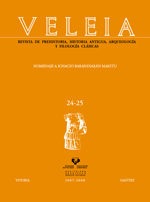La cueva drólica de Sarsa de Surta (Huesca). El arte rupestre que nunca fue y su yacimiento campaniforme
##plugins.themes.bootstrap3.article.main##
##plugins.themes.bootstrap3.article.sidebar##
Abstract
From 2001, our investigations in Cave Drólica are focus in two parallel lines: the study of some incised lines in the deepest area of the cave could remit us to a panel of rock art (palaeolithic?) and the archaeological dig of the vestibule, looking for the hypothetical relationship between a human occupation and those engravings. The prospections and preliminary digs have culminated in 2006 with a first archaeological campaign and an intensive study of the walls of the cave located in the pre-pirenaic mountains ranges of Huesca (Spain).
This work has allowed us to discard definitely the human origin for the parietal lines, all of them defined as bear scratches. We have also confirmed a human occupation in the vestibule, dated in the beginnings of the IV millennium BP (non calibrated), emphasizing the bell-beaker remains especially a great bomb-type pot, characteristic of Cienpozuelos domestic groups of the Meseta.
Finally, we have obtained a new radiocarbon date from an isolated charcoal recovered from the deep part of the cave that takes us to the VI millennium BP, and allows us to suspect a Neolithic occupation, not confirmed in the archaeological registration yet.
Downloads
##plugins.themes.bootstrap3.article.details##
Unless otherwise noted, the contents of the electronic edition of the OJS platform are licensed for use and distribution under a Creative Commons Attribution-NonCommercial-NoDerivatives 4.0 International (CC-BY-NC-ND) license.
The journal does not charge any financial compensation to authors for publishing in it and provides full access to the archives without any kind of embargo from the day of electronic publication. This respects the national open access policy.
All originals published in the journal Veleia, whether in print or digital format, are the property of the University of the Basque Country (UPV/EHU). © UPV/EHU
Authors of articles (whether research articles, news articles, news items or reviews) will be able to access their own work on the Journal's website. Authors will be able to put them in their personal repositories and will also have the possibility of pre-print dissemination of articles accepted for publication.

